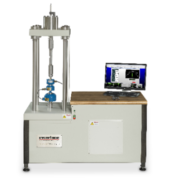The Role of Actuators in Force Measurement
 One of the most common force measurement tests in the engineering and manufacturing world is called cycle testing. Cycle testing involves constant force being applied to a component or product over hours, days and even months. The goal is to test a product to find out how long it will last under the amount of force it will see in use in the real world.
One of the most common force measurement tests in the engineering and manufacturing world is called cycle testing. Cycle testing involves constant force being applied to a component or product over hours, days and even months. The goal is to test a product to find out how long it will last under the amount of force it will see in use in the real world.
Cycle testing is used throughout different industries. One of the most common applications of a cycle test is on something like airplane wings. The wings of an airplane are exposed to constant push and pull force to guarantee that they will hold up over many flights. Check out the wing fatigue testing application note here.
Another example is simple furniture tests, like a chair, to ensure it can withstand the weight of people of all sizes after years and years of use. These tests are designed to really push the limits on the product so engineers and manufacturers can confirm their designs and ensure safety and durability.
To carry out these tests, actuators are used to generate the force in cycle testing. An actuator is a component responsible for moving and controlling a mechanism or system. Actuators are small components that convert energy in a linear moment. There are a variety of different types of actuators including linear, rotary, hydraulic, pneumatic, and more. Each is designed to create force in different directions and on different axes.
Actuators are very important because force measurement is fed back into a control loop and the actuator allows you to accurately control how much force you’re putting on a test article. As a basic example, if you wanted to measure how much force it takes to close a door, you would use an actuator to provide the door closing force while the load cell measures the amount of force given off by the actuator.
Interface often integrates actuators into load cells for custom solutions to use in rigorous use and cycle testing. These types of custom solutions are used by equipment and product manufacturers, OEMs, as well as product design and testing labs. There is increasing frequency for OEMs to integrate actuators into load cells for testing their automated testing lines or products in use for continuous feedback.
 For example, mobile device manufacturers use a miniature–sized load button load cell like the ConvexBT to test the pressure sensitivity of the touch screen. By using an actuator, phone manufacturers can set up an automated test lines with an actuator integrated in the load button load cell to test each screen as they go across a test line. You can read more about ConvexBT in this new white paper.
For example, mobile device manufacturers use a miniature–sized load button load cell like the ConvexBT to test the pressure sensitivity of the touch screen. By using an actuator, phone manufacturers can set up an automated test lines with an actuator integrated in the load button load cell to test each screen as they go across a test line. You can read more about ConvexBT in this new white paper.
Another major application for actuators is in calibration machines. To test if a load cell is calibrated correctly, an actuator applies force to the load cell being tested and a calibration grade Gold Standard Load Cell simultaneously. These measurements can tell the user if the load cell needs to be recalibrated or not because the actuator allows the user to create a very precise force measurement. If measurements on the test load cell are not the same as the control load cell, the user knows it is off calibration and it’s time to schedule a calibration service.
From custom solutions to calibration, if actuators are necessary for your next project learn how Interface can work with you to find a solution that meets your precise needs.
Read more about Gold Standard Calibration Systems here.
Learn about how Interface is a preferred provider of OEM solutions here.









